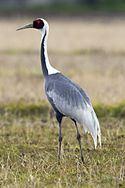Antigone (rodzaj)
| Antigone | |||
| Reichenbach, 1853[1] | |||
 Przedstawiciel rodzaju – żuraw białoszyi (A. vipio) | |||
| Systematyka | |||
| Domena | |||
|---|---|---|---|
| Królestwo | |||
| Typ | |||
| Podtyp | |||
| Gromada | |||
| Podgromada | |||
| Infragromada | |||
| Rząd | |||
| Nadrodzina | |||
| Rodzina | |||
| Podrodzina | |||
| Rodzaj | Antigone | ||
| Typ nomenklatoryczny | |||
Ardea antigone Linnaeus, 1758 | |||
| Synonimy | |||
| Gatunki | |||
| |||
Antigone – rodzaj ptaka z rodziny żurawi (Gruidae).
Zasięg występowania
Rodzaj obejmuje gatunki występujące w Ameryce Północnej (Kanada, Stany Zjednoczone, Meksyk i Kuba), Azji (Rosja, Chińska Republika Ludowa, Mongolia, Pakistan, Indie, Nepal, Bhutan, Bangladesz, Mjanma, Kambodża, Laos, Wietnam, Korea Południowa i Północna, Japonia i nowogwinejska część Indonezji) i Australazji (Papua-Nowa Gwinea i Australia)[6].
Morfologia
Długość ciała 120–176 cm, rozpiętość skrzydeł 160–280 cm; masa ciała 3350–12 240 g; samce są większe i cięższe od samic[6].
Systematyka
Etymologia
- Antigone: epitet gatunkowy Ardea antigone Linnaeus, 1758; w mitologii greckiej Antygona była córką Laomedona, króla Troi, która została zamieniona w bociana, bo ośmieliła się porównywać do bogini Hery; Karol Linneusz pomylił ten mit z mitem o Geranie, księżniczce Pigmejów, która została zamieniona w żurawia przez Herę za popełnienie tego samego rodzaju obrazy majestatu[7].
- Pseudogeranus: gr. ψευδος pseudos „fałszywy, inny”; γερανος geranos „żuraw”[8]. Gatunek typowy: Grus leucauchen Temminck, 1827 (= Grus vipio Pallas, 1811).
- Mathewsia: Gregory Macalister Mathews (1876–1949), australijski ornitolog amator, kolekcjoner[9]. Gatunek typowy: Ardea rubicunda Perry, 1810.
- Mathewsena: rodzaj Mathewsia Iredale, 1911; łac. przyrostek -ena „odnoszący się do”[10]. Nazwa zastępcza dla Mathewsia Iredale, 1811, ponieważ Iredale błędnie uważał, że nazwa ta jest zajęta przez Matthewsia Gemminger, 1868 (Coleoptera).
- Baeopteryx: gr. βαιος baios „mały, krótki”; πτερυξ pterux, πτερυγος pterugos „skrzydło”[11]. Gatunek typowy: †Baeopteryx latipes Wetmore, 1960.
Podział systematyczny
Taksony wyodrębnione z Grus[12]. Do rodzaju należą następujące gatunki[13]::
- Antigone canadensis (Linnaeus, 1758) – żuraw kanadyjski
- Antigone vipio (Pallas, 1811) – żuraw białoszyi
- Antigone antigone (Linnaeus, 1758) – żuraw indyjski
- Antigone rubicunda (Perry, 1810) – żuraw australijski
- Antigone cubensis (Fischer & Stephan, 1971) – wymarły, plejstoceński gatunek[14]
Przypisy
- ↑ H.G.L. Reichenbach: Avium systema naturale. Das natürliche system der vögel mit hundert tafeln grösstentheils original-abbildungen der bis jetzt entdecken fast zwölfhundert typischen formen. Vorlaüfer einer iconographie der arten der vögel aller welttheile. Dresden und Leipzig: Expedition der vollständigsten naturgeschichte, 1850, s. xiii. (niem.).
- ↑ R.B. Sharpe. The diagnoses of some apparently new genera of Cranes (Gruidæ). „Bulletin of the British Ornithologists’ Club”. 1, s. xxxvii, 1893. (ang.).
- ↑ T. Iredale. A new generic name, Mathewsia, for the “Australian Crane”. „Bulletin of the British Ornithologists’ Club”. 27, s. 47, 1911. (ang.).
- ↑ T. Iredale. The Genus-name Mathewsia. „Austral Avian Record”. 2, s. 81, 1913–1915. (ang.).
- ↑ A. Wetmore. Pleistocene birds in Bermuda. „Smithsonian miscellaneous Collections”. 140 (2), s. 6, 1960. (ang.).
- ↑ a b G.W. Archibald & C.D. Meine: Family Gruidae (Cranes). W: J. del Hoyo, A. Elliott & J. Sargatal: Handbook of the Birds of the World. Cz. 3: Hoatzin to Auks. Barcelona: Lynx Edicions, 1996, s. 83, 87. ISBN 84-87334-20-2. (ang.).
- ↑ Jobling 2021 ↓, s. Antigone.
- ↑ Jobling 2021 ↓, s. Pseudogeranus.
- ↑ Jobling 2021 ↓, s. Mathewsia.
- ↑ Jobling 2021 ↓, s. Mathewsena.
- ↑ Jobling 2021 ↓, s. Baeopteryx.
- ↑ E.C. Dickinson (red.) & J.V. Remsen Jr.: The Howard and Moore Complete Checklist of the Birds of the World. Cz. 1: Non-passerines. Eastbourne: Aves Press, 2013. ISBN 978-0-9568611-0-8. (ang.).
- ↑ Systematyka i nazwy polskie za: P. Mielczarek & M. Kuziemko: Podrodzina: Gruinae Vigors, 1825 - żurawie (wersja: 2017-06-25). [w:] Kompletna lista ptaków świata [on-line]. Instytut Nauk o Środowisku Uniwersytetu Jagiellońskiego. [dostęp 2020-04-02].
- ↑ William Suárez. The fossil avifauna of the tar seeps Las Breas de San Felipe, Matanzas, Cuba. „Zootaxa”. 4780 (1), s. 1–53, 2020. DOI: 10.11646/zootaxa.4780.1.1. (ang.).
Bibliografia
- James A. Jobling: The Key to Scientific Names. [w:] Birds of the World [on-line]. Cornell Laboratory of Ornithology, Ithaca, NY, USA, 2021. (ang.).
Media użyte na tej stronie
Autor: Spaceaero2, Licencja: CC BY-SA 3.0
White-naped Crane at Saijo,Ehime
